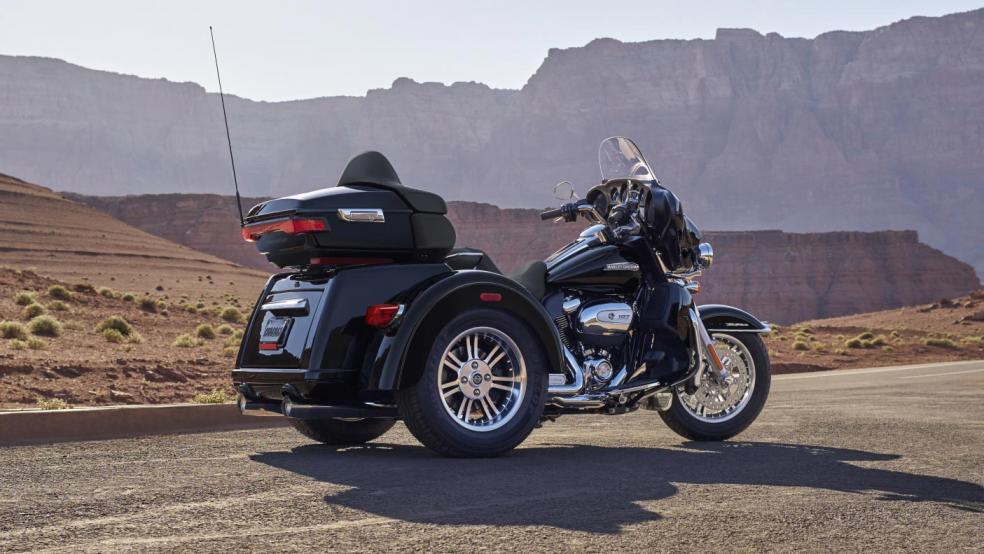When President Trump addressed the American people at a joint session of Congress last week, he touched on the deficit, tax reform, healthcare and national security. He also mentioned a leading American enterprise that’s innovating to meet changing market demands: Harley-Davidson. According to Trump, he “met with officials and workers from a great American company, Harley-Davidson. In fact, they proudly displayed five of their magnificent motorcycles, made in the USA, on the front lawn of the White House.”
What the president did not mention is Harley-Davidson’s unique strategy to re-design its products and shift its marketing strategies to retain current customers and find new ones in the growing 55+ demographic.
Related: 15 Great Jobs for Retirees
Harley-Davidson has been a pioneer by rethinking its business in light of the aging of society. Given that those of us over 60 in America hold 70 percent of disposable income, it’s not surprising that Harley Davidson would look for a growth strategy in that marketplace. What is surprising is how alone they are.
It’s worth taking a close look at what Harley-Davidson – a brand that positions itself as the antithesis of Velcro shoes and Bingo parlors – has done to adopt an aging strategy. In 2008, recognizing that its consumer base was growing older, Harley-Davidson introduced a three-wheeled “trike” that’s easier for older adults to ride and use. Offering greater stability and comfort than a traditional motorcycle, as well as added features like cruise control, high beams, and expanded trunk space, the trikes have become a popular option among Baby Boomer bikers who want to keep riding. In fact, the trikes have already shifted biker culture, becoming a common sight at motorcycle rallies and even prompting a designated, nationwide tricycle club, which already has chapters in 45 states.
This is exactly the kind of inventive thinking that American companies will need to stay competitive and grow in a market that itself is aging. Yet, product offerings and marketing strategies often ignore this massive segment of consumers. Not only does such oversight undermine a company’s potential growth and sales, it also dampens the creation of much-needed private sector innovations for the challenges and opportunities of aging.
And it won’t suffice to merely add an age-friendly spin to a product built for Millennials. Indeed, as Harley-Davidson’s trike indicates, reaching consumers aged 55 and older requires designing products and services expressly for their preferences, needs and tastes.
Related: What You Don’t Know About Medicare Could Hurt Your Retirement
Harley-Davidson has good company in other sectors:
* Financial services firms are focusing on retirement planning to help employees and investors – especially those approaching traditional retirement age – to manage their income, savings and portfolios across the life course. The need has never been greater, as 55 percent of American households are at risk of not being able to afford necessities like housing and health care in retirement. In response, pioneering companies are developing global centers and think tanks that provide resources, analysis and thought leadership to help people navigate their later-life finances and develop effective investing strategies. Designing investment strategies and tools aligned to 21st century longevity is practical and marketable.
* Tech visionaries are answering the call for solutions that can help consumers, families, societies, and health care systems address the mounting health needs and costs of demographic aging. Remote patient monitoring can help manage chronic and other conditions of aging at home, which could reduce costly hospitalizations and ER visits, improve health outcomes and save taxpayers billions in the coming decades. At the same time, home care companies are disrupting elder care with a model that fits most older adults’ desire to age in their own home. Such models are not only desired, but they entail far fewer costs than assisted living facilities -- and they create jobs. Such cost-effective, high-quality care will become increasingly critical for aging populations around the world, from Europe to the U.S. to Asia.
* Though the fashion, technology, and entertainment industries are often youth-focused, if not youth-obsessed, leaders in each are turning towards older consumers. For example, textile manufacturers are teaming up with leading-edge tech firms to incorporate the “internet of things” into fabrics, creating the potential for “smart” apparel that helps older adults to realize the benefits of healthy, active aging. Or consider singer Jimmy Buffett’s recent announcement that he will be applying his iconic lifestyle brand to a $1 billion Margaritaville retirement community. This development will combine a walkable, amenity-rich neighborhood, tropical themes and a beachfront club to appeal to fans who want to maintain their active lifestyle past 55.
These forward-looking companies are sparking a revolution in the private sector, one that centers on the older consumer, traveler, patient, jogger, fan and biker. These innovations seize the huge potential of the silver economy estimated at about $15 trillion globally -- in which older adults are redefined as a powerful driver for economic growth and commercial breakthroughs, not merely the entitlement recipients of 20th century social welfare models.
Related: 8 Things You Need to Do to Get Ready for Retirement
If President Trump wants to drive progress towards his policy goals – from high economic growth to Medicare cost savings to infrastructure improvements – he should look to the private sector leaders who are already engaging with the aging macrotrend. And he shouldn’t have to look far: some of these leaders were on the White House lawn, where they might have talked about their three-wheeled motorcycle, re-designed for an Aging American Public.





